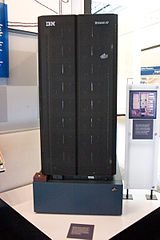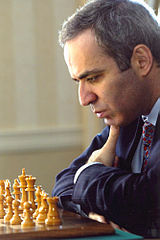
- Chess World Cup
- FIDE Grand Prix
- Olympiad
- World Championship
- List of strong tournaments
- List of world championships

- Checkmate patterns
- Chess openings
- Chess strategy
- Chess tactics
- Chess theory
- Endgames
- Pawn structure
- Problems/Compositions












 Deep Blue vs. Kasparov chess matches
Deep Blue vs. Kasparov chess matches Deep Blue
Deep Blue
Second match (rematch)
Deep Blue vs. Garry Kasparov was a pair of six-game chess matches between chess champion Garry Kasparov and an IBM supercomputer called Deep Blue. The first match was played in Philadelphia in 1996 and won by Kasparov. The second was played in New York City in 1997 and won by Deep Blue. The 1997 match was the first defeat of a reigning world chess champion to a computer under tournament conditions.
The 1997 match was the subject of a documentary film, The Man vs. The Machine.
| Game # | White | Black | Result | Comment |
|---|---|---|---|---|
| 1 | Deep Blue | Kasparov | 1-0 | |
| 2 | Kasparov | Deep Blue | 1-0 | |
| 3 | Deep Blue | Kasparov | ½-½ | Draw by mutual agreement |
| 4 | Kasparov | Deep Blue | ½-½ | Draw by mutual agreement |
| 5 | Deep Blue | Kasparov | 0-1 | Kasparov offered a draw after the 23rd move. |
| 6 | Kasparov | Deep Blue | 1-0 | |
| Result: Kasparov-Deep Blue: 4-2 | ||||
| Game # | White | Black | Result | Comment |
|---|---|---|---|---|
| 1 | Kasparov | Deep Blue | 1-0 | |
| 2 | Deep Blue | Kasparov | 1-0 | |
| 3 | Kasparov | Deep Blue | ½-½ | Draw by mutual agreement |
| 4 | Deep Blue | Kasparov | ½-½ | Draw by mutual agreement |
| 5 | Kasparov | Deep Blue | ½-½ | Draw by mutual agreement |
| 6 | Deep Blue | Kasparov | 1-0 | |
| Result: Deep Blue-Kasparov: 3½-2½ | ||||
| a | b | c | d | e | f | g | h | ||
| 8 |

              |
8 | |||||||
| 7 | 7 | ||||||||
| 6 | 6 | ||||||||
| 5 | 5 | ||||||||
| 4 | 4 | ||||||||
| 3 | 3 | ||||||||
| 2 | 2 | ||||||||
| 1 | 1 | ||||||||
| a | b | c | d | e | f | g | h | ||
Read main article: Deep Blue versus Kasparov, 1996, Game 1
The first game of the 1996 match was the first game to be won by a chess-playing computer against a reigning world champion under normal chess tournament conditions, and in particular, classical time controls.
The game was played on February 10, 1996.
The second game began with the Open Catalan Opening. Kasparov played in what could be called a preemptive style blocking all Deep Blue's development attempts. The game lasted for 73 moves but eventually Deep Blue's operator had to resign the game for the computer in a position where both players had a bishop but Kasparov had three pawns to Deep Blue's one.
The game was played on February 11, 1996.
In the third game Kasparov played the Sicilian Defence to which Deep Blue responded with the Alapin Variation. The game lasted for 39 moves and was drawn.
The game was played on February 13, 1996.
The fourth game was the second game to end in a draw, even though at one point Deep Blue's team refused Kasparov's draw offer. The opening played was the Semi-Slav Defense.
The game was played on February 14, 1996.
The fifth game was the turning point in the match. During the game, Kasparov, playing Black, chose a different opening, the Four Knights Game, from the Sicilian Defence he had played in games one and three and came out on top. This was particularly embarrassing for the Deep Blue team, because they had declined Kasparov's draw offer after the 23rd move. This was the only game in the match that Black won.
The game was played on February 16, 1996.
| a | b | c | d | e | f | g | h | ||
| 8 |

                       |
8 | |||||||
| 7 | 7 | ||||||||
| 6 | 6 | ||||||||
| 5 | 5 | ||||||||
| 4 | 4 | ||||||||
| 3 | 3 | ||||||||
| 2 | 2 | ||||||||
| 1 | 1 | ||||||||
| a | b | c | d | e | f | g | h | ||
In the end of the sixth game, Deep Blue's pieces were crammed into its queen side corner, and unable to defend its king. Kasparov's next move would probably have been 44.Qe7 to exchange the queens. That would have allowed his pawn, which was about to promote, to advance.
The game was played on February 17, 1996.
The 1997 rematch began with the King's Indian Attack, which led Kasparov to victory in 45 moves.
This game was played on May 3, 1997.
Deep Blue's 44th move in this game puzzled Kasparov, and he attributed it to "superior intelligence". Allegedly, the move was a result of a bug in which Deep Blue, unable to determine a desirable move, resorted to a fail-safe. Nate Silver proposes that Kasparov "concluded that the counterintuitive play must be a sign of superior intelligence", leading him to lose the second game.
In this game Kasparov accused IBM of cheating, a claim repeated in the documentary Game Over: Kasparov and the Machine. Kasparov eventually resigned, although post-game analysis indicates that the game could have been drawn. The game started with the Ruy Lopez opening, Smyslov Defence variation.
This game was played on May 4, 1997.
At the time it was reported that Kasparov missed the fact that after 45...Qe3 46.Qxd6 Re8, Black (Kasparov) can force a draw by perpetual check (threefold repetition). His friends told him so the next morning. They suggested 47.h4 h5!, a position after which the black queen can perpetually check White. This is possible because Deep Blue moved 44.Kf1 instead of an alternate move of its king. Regarding the end of game 2 and 44.Kf1 in particular, chess journalist Mig Greengard in the Game Over film states, "It turns out, that the position in, here at the end is actually a draw, and that, one of Deep Blue's final moves was a terrible error, because Deep Blue has two choices here. It can move its king here or move its king over here. It picked the wrong place to step." Another in that film, four-time US champion Yasser Seirawan, then concludes that, "The computer had left its king a little un-defended. And Garry could have threatened a perpetual check, not a win but a perpetual check."
Today strongest computer chess engines, for example Stockfish, which are stronger than every human, don't consider the final position as simple draw, but as having better winning chances for white, contradicting the human analysis at the time that Deep Blue missed a perpetual check. The winning move for Deep Blue was 45.Qd7+.
The third game was interesting because Kasparov chose to use an irregular opening, the Mieses Opening. He believed that by playing an esoteric opening, the computer would get out of its opening book and play the opening worse than it would have done using the book. Although this is nowadays a common tactic, it was a relatively new idea at the time. Despite this anti-computer tactic, the game was drawn.
This game was played on May 6, 1997.
In this game Kasparov played the Caro-Kann Defence. Kasparov got into time trouble late in the game. The sub-optimal moves he played in a hurry may have cost him the victory.
This game was played on May 7, 1997.
| a | b | c | d | e | f | g | h | ||
| 8 |

           |
8 | |||||||
| 7 | 7 | ||||||||
| 6 | 6 | ||||||||
| 5 | 5 | ||||||||
| 4 | 4 | ||||||||
| 3 | 3 | ||||||||
| 2 | 2 | ||||||||
| 1 | 1 | ||||||||
| a | b | c | d | e | f | g | h | ||
In this game, the King's Indian Attack opening was played. As in the previous game, Deep Blue played a brilliant endgame that secured a draw, when it was looking as if Kasparov would win.
This game was played on May 10, 1997.
If White plays 50.g8=Q then Black can force a draw by threefold repetition, starting with 50...Rd1+ and then 51...Rd2+.
Deep Blue-Kasparov, 1997 game 6| a | b | c | d | e | f | g | h | ||
| 8 |

                              |
8 | |||||||
| 7 | 7 | ||||||||
| 6 | 6 | ||||||||
| 5 | 5 | ||||||||
| 4 | 4 | ||||||||
| 3 | 3 | ||||||||
| 2 | 2 | ||||||||
| 1 | 1 | ||||||||
| a | b | c | d | e | f | g | h | ||
Read main article: Deep Blue versus Kasparov, 1997, Game 6
Before the sixth game, the overall score was even: 2½-2½. As in game 4, Kasparov played the Caro-Kann Defence. He then allowed Deep Blue to make a daring knight sacrifice which wrecked his defence and forced him to resign in fewer than twenty moves
This game was played on May 11, 1997.